How to get a rich harvest of onion: cultivation and care, photo of the vegetable
Onion has excellent taste. It is used not only in cooking, but also in medicine. The vegetable is rich in vitamins, micro- and macroelements, which have a beneficial effect on the entire human body.
Let's figure out how to plant onions, grow and care for them in order to get a rich harvest.
What type of onion is this?
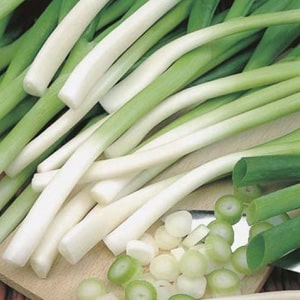
A distinctive feature of the perennial onion is the presence of a small head (false onion) with low-juice and thin scales.
It is unsuitable for winter storage, so the plant is grown for greens. Onion leaves are superior in taste to green onions; they are softer and more tender.
The plant's bulb is poorly developed, has an oblong shape, and tastes slightly spicy and crunchy. The greenery (falute leaves) reaches a height of 40-60 cm, about 2 cm in diameter. In the second year, the bow shoots arrows up to 45 cm high.
The feathers of the plant are highly frost-resistant and can tolerate temperatures as low as -8°C.
They contain large amounts of vitamin C, as well as essential oils, sugar, protein, carotene, iron, potassium and magnesium.
Onion has high productivity for 3-4 years, and under the right agrotechnical conditions, a good harvest can be obtained up to 5-7 years. Up to 2 kg of greenery is cut from 1 m² at a time, and up to 10 kg over the summer.
Advice. Experienced gardeners recommend replant onion every 3-4 years, since as the underground part grows, its productivity decreases.
The best varieties of onion
There are many varieties of spring onions, let's look at the most popular ones.
May
Early ripening variety, begins to germinate after soil thaws. The plant of this variety is of medium height, erect, with an average degree of branching. The greens have a slight waxy coating, they are juicy, with a slightly pungent, spicy taste. Contains large amounts of sugar.
The growing season is 142-155 days. This variety is characterized by high yield, winter hardiness and increased resistance to disease.
April
The variety is early ripening. The growing season from full germination to mass death is 102-142 days. The greens are juicy, tender, and do not become rough for a long time.
The taste is medium hot. It has high yield, frost resistance and disease resistance.
Sunrise
An early ripening variety of onion, frost-resistant. The period of germination of green shoots from the moment of sowing seeds in open ground is about 40 days. The greens grow up to 30 cm in height, juicy, but very fragile.
The taste is sharp, with a slight bitterness. The variety is characterized by average yield.
Baia Verde
An early hybrid variety, obtained by crossing spring onions with onions. Frost-resistant and high-yielding. The first greenery appears after the snow melts. The plant is of medium height, the greens are dark green in color with a waxy coating. The taste is spicy.
Russian winter
An early ripening variety, frost-resistant, produces a high yield. The period from planting seeds in the ground to germination of shoots is 30 days. Easily adapts to your favorite climatic conditions.
Suitable for growing in the northern regions of the country. Plant height is up to 30-33 cm, the taste is slightly pungent.
Giant
Mid-season variety. The period from the beginning of germination to technical maturity is 30-37 days.Wide spreading bush with strong thick greenery up to 50 cm long.
The taste is mildly spicy. It is frost-resistant and resistant to fungal attack.
Gribovsky
Late ripening variety, high yielding. Branched, powerful bush up to 30 cm high. Mild taste, medium spicy.
The variety is resistant to various diseases and stores well.
Correct fit
Onion sown before winter (in November), spring landing produced at the end of April and continues until mid-July.
Before planting, onion seeds are soaked in a warm solution of potassium permanganate for 20 minutes, then leave for a day in ordinary warm water, which is changed 2-3 times. After which they are dried to a free-flowing state and sown. The process of soaking seeds accelerates the emergence of seedlings by 5-7 days.
Advice. The seeds are soaked in a special solution of microfertilizers (1 tablet per 1 liter of water). Be sure to control the process: if they sprout long shoots, this will complicate planting.
When choosing a planting site, keep in mind that the plant is perennial and will occupy it for a long time.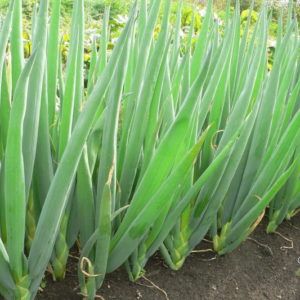
Onion yields more on turf soils rich in humus and with a low acidity level. The optimal pH level is 6.5-7.5. Does not grow well in clay or waterlogged soils.
The ideal predecessors of onion are legumes, radishes and dill. It is not recommended to plant it after tomatoes, garlic, carrots, cucumbers or onions; there is a risk of infection with various diseases.
Since the onion does not like bright sunny color, it is better to plant it along the fence, not far from the trees, so that there is partial shade. Choose a flat place, without slopes.
To obtain a rich harvest of onions, the soil is prepared in advance.
In the fall, when digging, add 1-2 buckets of humus or compost per 1 m².Potassium and phosphorus fertilizers are added to depleted soils. Per 1 m² - 15 g of potassium chloride, 25 g of superphosphate, 25 g of ammonium nitrate. If the soils are acidic, add fluff lime.
In spring, the soil is prepared two weeks before planting. Humus, potassium and phosphorus fertilizers are applied as in the fall. To reduce acidity, add wood ash (150 g of ash per 1 m²).
After digging, the area is harrowed and beds are formed, the distance between them is at least 30 cm. Before adding seed, the soil is moistened. The seed sowing rate is 1.5 g per 1 m².
The seeds are sown to a depth of 2-3 cm, the distance between the rows is 18-25 cm. Then the crops are mulched with a layer of humus of 1-1.5 cm and compacted. The first shoots appear on days 11-17.
Growing through seedlings
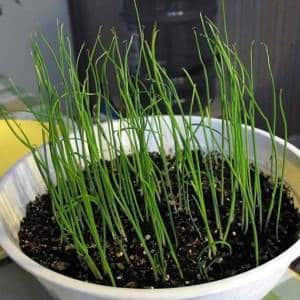 Onions are grown not only from seeds, but also by sowing seedlings.
Onions are grown not only from seeds, but also by sowing seedlings.
Before sowing seedlings, onion seeds are kept in the refrigerator for 2 days at a temperature of +6°C. Then wrap it in a damp cloth for a day. After which the seeds are dried.
The soil for seedlings is prepared as follows: mix garden soil and rotted manure in a 1:1 ratio, add ash and superphosphate, moisten with a solution of potassium permanganate.
Prepared seeds are sown in containers to a depth of 1 cm, the distance between furrows is 3-4 cm. Cover with soil and water. Seedlings are sown when the soil warms up to +12°C, to a depth of 1.5 cm, the distance between seedlings is 3 cm.
Further care
Further cultivation and care of the perennial onion (photo below) consists of watering, fertilizing, weeding, thinning and loosening.
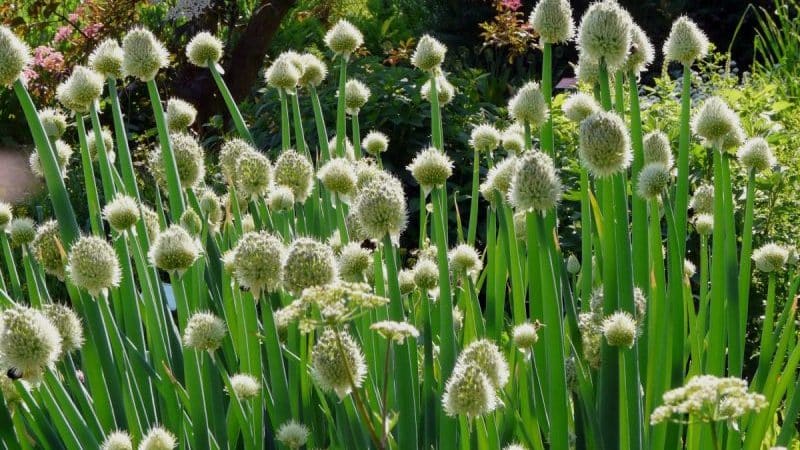
Watering
Water the onion twice a week, in dry times - every other day. 10 liters of water are poured per 1 m², the soil should be moistened by 20 cm.
If there is not enough moisture, the onion takes on a bluish-white hue, and its tips become bent. When there is excess moisture, it turns pale green.
Top dressing
During growth, the spring onion needs feeding. After the first shoots appear, organic fertilizers are applied to the ground (mullein in a ratio of 1:8 or an infusion of bird droppings 1:20).
In the fall, when the harvest is harvested, fertilizing is carried out with liquid mineral fertilizers: 50 g of ammonium nitrate, 3 g of superphosphate, 20 g of potassium chloride per 10 liters of water.
Weeding
Weed the onion as it becomes overgrown. After weeding, the soil must be loosened. Loosening promotes the respiration of onion roots and accelerates its growth.
Onions are thinned out so that the distance between plants is 6-9 cm.
At the beginning of July, the lower green feather is trimmed. Only young light green leaves are left. By the beginning of autumn, the greenery will be completely restored.
In autumn, spring onions do not need care. Beds with green feathers are left on winter. In spring, onions are cleaned by raking up dried leaves.
Disease and pest control
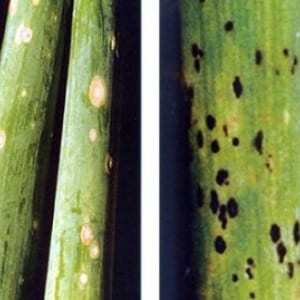
Most often, spring onions suffer from fungal diseases. To prevent their development, do not flood the plants when watering, thin out and remove weeds.
Downy mildew
Main signs: the appearance of a grayish coating and rusty spots on the greenery.
To combat it, onions are sprayed with a solution of copper sulfate (10 g of copper sulfate per 0.5 liters of water) or soda ash (1 tbsp per 10 liters of water).
Rust
Characteristic signs of the disease include the appearance of yellow-brown spots that spread throughout the entire leaf, then it dies.
To combat the disease, onions are sprayed with the preparation “HOM” (40 g per 10 liters of water). After a week, the spraying process is repeated.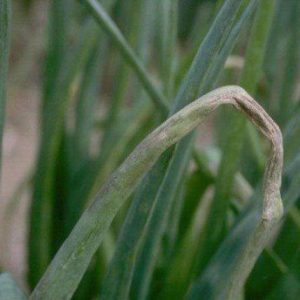
Fusarium
The bottom of the bulb softens and rots, the root system dies, the leaves turn yellow, and the plant dies.
To prevent the development of the disease, the soil is treated with the fungicidal agent “Quadris”. The standards are indicated by the manufacturer on the packaging.
Onion pests
The main pests of onions:
- secretive beetle - trims onion leaves, lays larvae that eat the greens from the inside;
- root mite - gnaws at the bottom and penetrates inside the plant, causing it to rot;
- mole cricket - gnaws onion roots and stems;
- tobacco onion thrips - forms silvery spots on the leaves and leaves its excrement.
To combat pests, mustard powder is sprinkled on the beds, which repels them with its smell.
To get rid of insects, onions are sprayed with special products: “Iskra”, “Karbofos”, “Fitofarm-M”.
Features of growing in open ground
In the first year They stop cutting greens from onions before the onset of autumn so that the false onion has time to accumulate enough nutrients to survive the winter.
In the second year for feeding, nitroammophoska (0.05 kg per 1 m²) and humus (7 kg per 1 m²) are added to the thawed soil, and dried leaves are removed. After 20 days, the first harvest is harvested, and after 50 days, the second.
In the third year repeat all processes. At the last harvest, which is made before August 1, the trumpet is not cut off, but dug up along with the bulb. This completes the production cycle of the plant.
In the greenhouse
A distinctive feature of the spring onion is that its growth does not depend on the length of daylight hours. When planted in November, the harvest is harvested after 25-28 days, in January - after 19-21 days, in February - after 14-16 days.
In a greenhouse, onions need regular watering, air humidity should be 80-85%
Features of cultivation and care depending on the region
In central Russia, onions are sown after April 10, in the south - in early March. Regardless of the region, onion care is standard: mandatory weeding, loosening, thinning and watering.
In the northern regions, it is not recommended to cut off young feathers in the first year of life. The root system must be well strengthened to withstand the harsh winter. When the leaves are cut, he will use all his strength to restore them to the detriment of the root system.
Harvest and storage
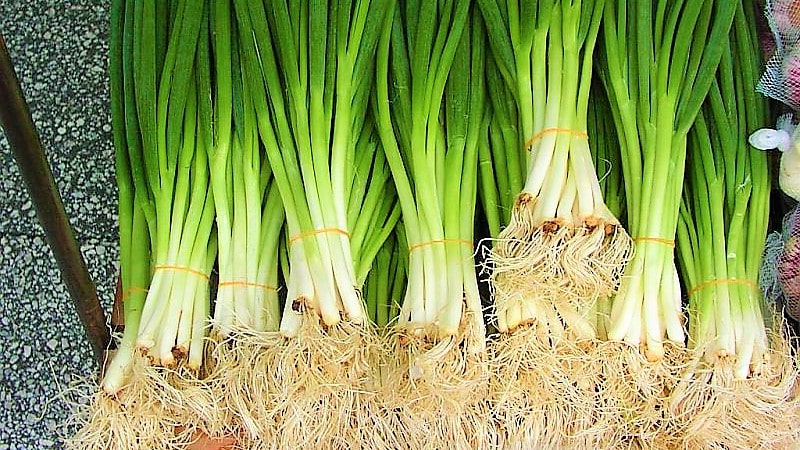
Greens are cut 30 days after the first shoots. After 45 days, final cleaning is performed.
Feathers are trimmed with a knife or torn off by hand at least 5 cm from the soil. They are packed in polyethylene or laid out in plastic boxes. Store in a cool, dark place.
The loaf can be stored in the refrigerator in the vegetable compartment for up to 30 days.
For longer storage it is frozen. To do this, the greens are chopped, placed in bags or containers and placed in the freezer. Shelf life - 1 year.
Chopped onion leaves are dried in an oven, electric dryer or in the open air. Store in paper bags or glass jars for up to 1 year. Used as a seasoning for various dishes.
Conclusion
Onion is a perennial plant. Its distinctive feature is its undeveloped bulb. Therefore, it is grown for greens, which, unlike onions, are softer and more tender.
The vegetable is undemanding to climatic conditions and care, and is resistant to diseases. If you follow simple agricultural techniques, you will get a rich harvest of tasty, juicy and healthy onions.